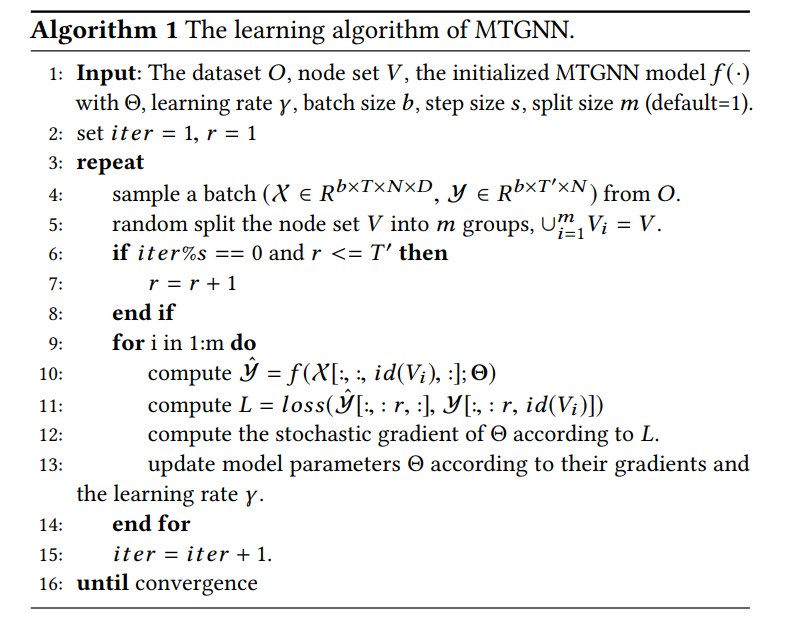Connecting the Dots ; MTS Forecasting with GNNs (2020, 147)
Contents
- Abstract
- Introduction
- Problem Formulation
- Framework of MTGNN
- Model Architecture
- Graph Learning Layer
- Graph Convolution Module
- Temporal Convolution Module
- Skipped Connection Layer & Output Module
- Proposed Learning Algorithm
Abstract
modeling MTS
-
variables depend on each other!
\(\rightarrow\) use GNN to capture relational dependencies!
propose a general GNN for MTS
-
automatically extracts uni-direction relations among variables, through graph learning module
( external knowledge can be integrated )
-
novel mix-hop propagation layer & dilated inception layer
( capture spatial & temporal dependencies )
-
3 components
- (1) graph learning
- (2) graph convolution
- (3) temporal convolutions
are jointly learned
1. Introduction
background of GNN’s success
- 1) permutation-invariance
- 2) local connectivity
- 3) compositionality
GNN for MTS : “spatial-temporal GNNs”
- input : MTS & external graph structures
- goal : predict future values/labels
challenges of those models
-
1) Unknown graph structure
-
rely heavily on pre-defined graph structure
\(\rightarrow\) but in most cases, it doesn’t exists
-
-
2) Graph Learning & GNN Learning
-
most GNN focus only on “message passing” (GNN learning)
( ignore the fact that “graph structure isn’t optimal” )
-
so, how to learn those 2 simultaneously??
-
3 components ( all end-to-end )
- 1) graph learning layer
- to overcome challenge (1)
- 2) graph convolution module
- to capture spatial dependencies among variables
- 3) temporal convolution module
- to capture temporal patterns, with modified 1d conv
Advantages : applicable to….
- 1) both small & large graphs,
- 2) both short & long TS,
- 3) with/without externally defined graph structures
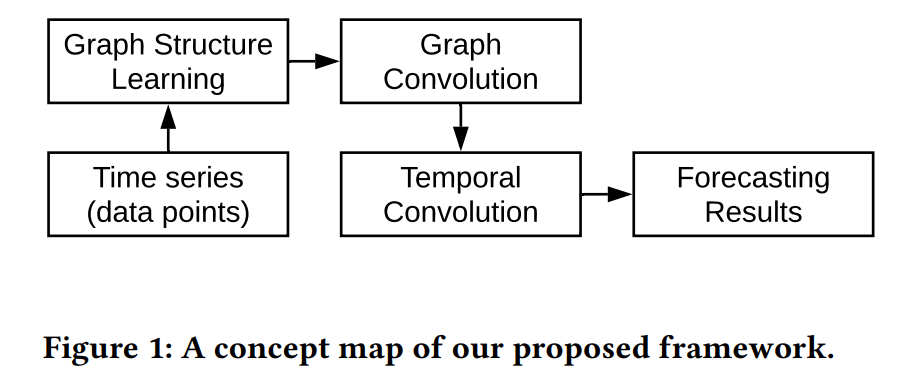
2. Problem Formulation
Input = observed MTS : \(\mathrm{X}=\left\{\mathrm{z}_{t_{1}}, \mathrm{z}_{t_{2}}, \cdots, \mathrm{z}_{t_{P}}\right\}\)
- \(\mathbf{z}_{t} \in \mathbf{R}^{N}\) : multivariate variable of dimension \(N\) at time step \(t\)
- \(z_{t}[i] \in R\) : value of the \(i^{t h}\) variable at time step \(t\)
Target :
- 1) \(Q\)-step-away value : \(\mathbf{Y}=\left\{\mathbf{z}_{t_{P+Q}}\right\}\)
- 2) sequence of future values : \(\mathbf{Y}=\left\{\mathbf{z}_{t_{P+1}}, \mathbf{z}_{t_{P+2}}, \cdots, \mathbf{z}_{t_{P+Q}}\right\}\)
Concatenated input signals
- \(\mathcal{X}=\left\{\mathrm{S}_{t_{1}}, \mathrm{~S}_{t_{2}}, \cdots, \mathrm{S}_{t_{P}}\right\}\).
- \(\mathrm{S}_{t_{i}} \in \mathbf{R}^{N \times D}\), where \(D\) is feature dimension
- first column : \(\mathrm{z}_{t_{i}}\)
- other columns : auxiliary features
- \(\mathrm{S}_{t_{i}} \in \mathbf{R}^{N \times D}\), where \(D\) is feature dimension
3. Framework of MTGNN
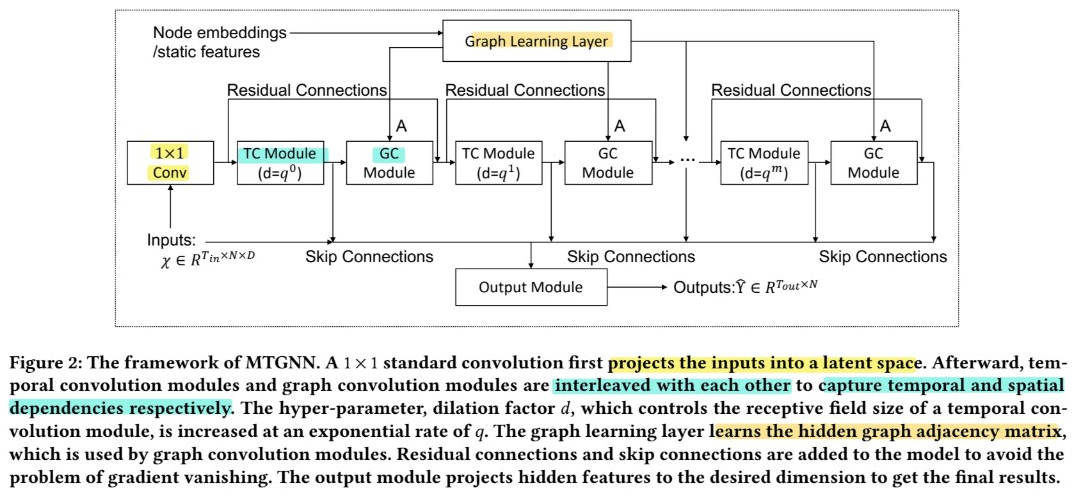
(1) Model Architecture
Components
- graph learning layer (1)
- computes a graph adjacency matrix
- used as an input to all graph convolution modules
- graph convolution modules (m)
- capture spatial dependencies
- temporal convolution module (m)
- capture temporal dependencies
ETC
- residual connections & skip connections
(2) Graph Learning Layer
goal : capture hidden relations among TS data
Similarity measure
- ex) dot product, Euclidean distance
[ Problem 1 ] high time & space complexity
- solution : sampling approach
- only calculate pair-wise relationships among a subset of nodes
[ Problem 2 ] symmetric/bi-directional
-
can not capture “cause” of the change
( should be uni-directional )
-
solution :
\(\begin{aligned} &\mathbf{M}_{1}=\tanh \left(\alpha \mathbf{E}_{1} \boldsymbol{\Theta}_{1}\right) \\ &\mathbf{M}_{2}=\tanh \left(\alpha \mathbf{E}_{2} \boldsymbol{\Theta}_{2}\right) \\ &\mathbf{A}=\operatorname{ReLU}\left(\tanh \left(\alpha\left(\mathbf{M}_{1} \mathbf{M}_{2}^{T}-\mathbf{M}_{2} \mathbf{M}_{1}^{T}\right)\right)\right) \\ &\text { for } i=1,2, \cdots, N \\ &\mathbf{i d x}=\operatorname{argtopk}(\mathbf{A}[i,:]) \\ &\mathbf{A}[i,-\mathbf{i d x}]=0, \end{aligned}\).
Incorporate external data
- if exists, can also set \(\mathbf{E}_1 = \mathbf{E}_2 = \mathbf{Z}\)
(3) Graph Convolution Module
Goal : handle spatial dependencies
Consists of 2 mix-hop propogation layers
- consists of 2 steps
- 1) information propagation step
- \(\mathbf{H}^{(k)}=\beta \mathbf{H}_{i n}+(1-\beta) \tilde{\mathbf{A}} \mathbf{H}^{(k-1)}\).
- 2) information selection step
- \(\mathbf{H}_{o u t}=\sum_{i=0}^{K} \mathbf{H}^{(k)} \mathbf{W}^{(k)}\).
- \(\mathbf{W}^{(k)}\) : act as “feature selector”
- \(\mathbf{H}_{o u t}=\sum_{i=0}^{K} \mathbf{H}^{(k)} \mathbf{W}^{(k)}\).
- \(\mathbf{H}^{(0)}=\mathbf{H}_{i n}, \tilde{\mathbf{A}}=\) \(\tilde{\mathbf{D}}^{-1}(\mathbf{A}+\mathbf{I})\), and \(\tilde{\mathbf{D}}_{i i}=1+\sum_{j} \mathbf{A}_{i j} .\)
- 1) information propagation step
Concatenate information from different hops
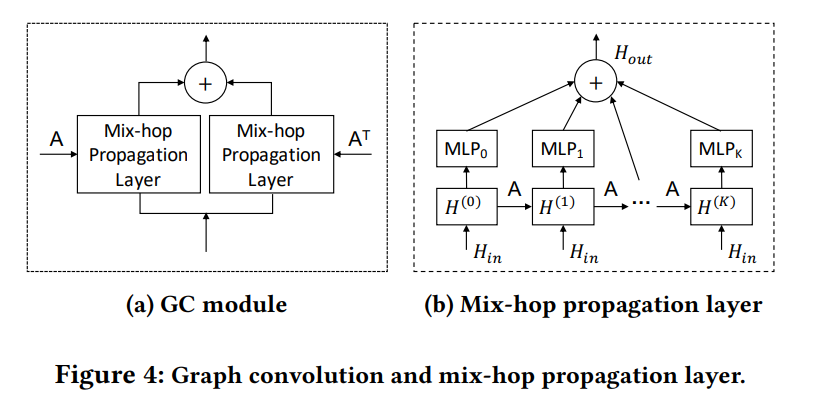
(4) Temporal Convolution Module
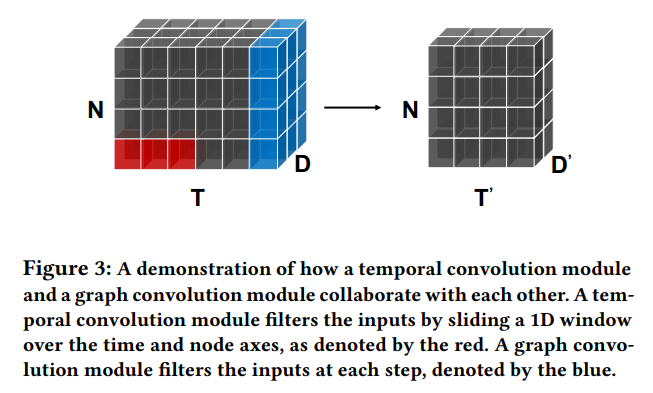
set of dilated 1d conv filters
consists of 2 layers
- 1) with tangent hyperbolic activation function
- 2) with sigmoid activation function
Dilated Inception Layer
able to both discover “temporal patterns” with various ranges
& handle “very long sequences”
\(\rightarrow\) propose a dilated inception layer
( use filters with multiple sizes & apply dilated convolution )
Details
- 1) consist of 4 filter sizes \(\rightarrow\) combination
- 2) dilated convolution, for larger receptive fields

Combine inception & dilation
\(\mathbf{z}=\operatorname{concat}\left(\mathbf{z} \star \mathbf{f}_{1 \times 2}, \mathbf{z} \star \mathbf{f}_{1 \times 3}, \mathbf{z} \star \mathbf{f}_{1 \times 6}, \mathbf{z} \star \mathbf{f}_{1 \times 7}\right)\).
- where \(\mathbf{z} \star \mathbf{f}_{1 \times k}(t)=\sum_{s=0}^{k-1} \mathbf{f}_{1 \times k}(s) \mathbf{z}(t-d \times s)\)
(5) Skipped Connection Layer & Output Module
Skipped Connection
- to prevent gradient vanishing
Output module
- predict certain future step : output dim = 1
- predict \(Q\) future step : output dim = \(Q\)
(6) Proposed Learning Algorithm
